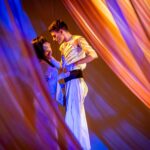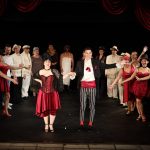Summary
The cave and the shadows is a vanguard performance, created after the idea and pictures of Sasho Anastasov, who is a famous Bulgarian painter.
The projection of the graphical images on the screen and the graceful impression of human body movements do create a new world of suggestion.
The music of Harold Budd is an important integral part of the feeling of touching an imaginary reality.
The cave and the shadows is a visual performance, where the vehicles of expression of fine arts and acting are entangled. This symbiosis leads to the creation of artistic beauty of a new kind where style and precise wording represent the basic principle of staging.
The ideas of performance are based on the philosophical concepts of Plato as elaborated in his work The State. According to the great philosopher we all live in a cave turning our backs towards the light which makes us to perceive our shadows as the only real world.
The immediate effect of the light upon the density of dark captivates the audience into the labyrinth of subconscious, where the mere necessity of determining the clear boundaries between real and imaginary disappears.
Aesthetics in black and white, style, music, plastics and images - this is the unique world of the sensitive performance The Cave and the Shadows.
Since its very production, it enjoys a huge international interest and is invited by ones of the biggest production houses all over the world.
Communicative and accessible, with no words, with a strong effect on the audience.
For adults
Duration: 60 min.
Let me show in a figure how far our nature is enlightened or unenlightened: --Behold! human beings living in a underground cave, which has a mouth open towards the light and reaching all along the cave; here they have been from their childhood, and have their legs and necks chained so that they cannot move, and can only see before them, being prevented by the chains from turning round their heads. Above and behind them a fire is blazing at a distance, and between the fire and the prisoners there is a raised way; and you will see, if you look, a low wall built along the way, like the screen which marionette players have in front of them, over which they show the puppets. PLATO, The State.
The objective of this performance is to bring together in a syncretic way the means of expression of graphics, playing body and music to "visualize” the sophisticated relationship between nature and art on one hand and between the human and ideal, on the other hand.
At the beginning, the bodies look like give up doing their natural every day movements to get transformed into an aesthetical tool the function of which is to reproduce the shapes of the pieces of art projected on the screen. In other words, human body leaves its naturalness to join the graphical art that is already detached from its creator’s naturalness.
This way, the human body tries to amalgamate with what is beyond because the artist's art has an ambitious and bold vision to itself as a view of the world beyond its material existence. We may accept that we actually see a copy of the ideal true Plato's world of shapes that is somewhere behind the screen. By definition the ideal shapes are clear, simple and static. They are not accessible to the man dressed in the body dynamics and may only at some extent be imitated by our restricted material means of expression. In this sense, if we examine the static and economical graphics as a copy of the ideal, then the playing bodies appear to be imitation of imitation. Their incapacity to reproduce exactly the graphic lines brings us to the idea of the original drama of human existence that has its roots at the imperfectness and extreme character of our materiality. As Shelley writes, the shadow of mortality always lies between the ideal concept and the material expression. The complete amalgamation or coincidence with the ideal is beyond man’s limits.
Hope appears in the second part of the performance where the bodies give up trying to reproduce the ideal shapes. Instead, by a sequence of visual effects, they try to and succeed in stirring the static graphical lines. Thus, the illusion is created that the static perfection is undermined. That’s to say, the ideal is involved into the playing human body’s dynamics. This looks like being the maximum that the body may achieve with respect to the ideal. Giving up being natural and turning into a tool of art, it may play with but not simply in front of the ideal, to manipulate it, to make it “move”, to adapt it to its changeability. This is a way that human nature achieve at least partial enlightenment even if chained in the cave for ever.
Which is the role of music in this context? It looks like it comes from behind the screen and is far from being simply a background in this sense. It stays behind as a connecting unit between the imitation and the true shapes. In all cases, it comes from the space that is closer to the ideal than the lines of the bodies.
Lyubomir Terziev
5thInternational Puppet Theatre Festival for Adults Pierrot, Stara Zagora, 2007
Award for Experimental and New Forms for The Cave and the Shadows
Varna 2007 Award – collective,for the artistic team having realized the performance The Cave and the Shadows
14th International Puppet Festival The Golden Dolphin, 2008
- Prize for development of the theatre's means of expression - for The Cave and the Shadows;
Sasho Anastasov - idea, scenography and visions
Staging Vera Stoykova
Music Harold Budd
Cast:
Emilia Petkova, Stoyan Stoyanov, Diana Tsolevska, Boyan Stoyanov, Evgeniya Vasileva, Galin Ginev, Veselina Kalcheva, Gergana Gospodinova

















